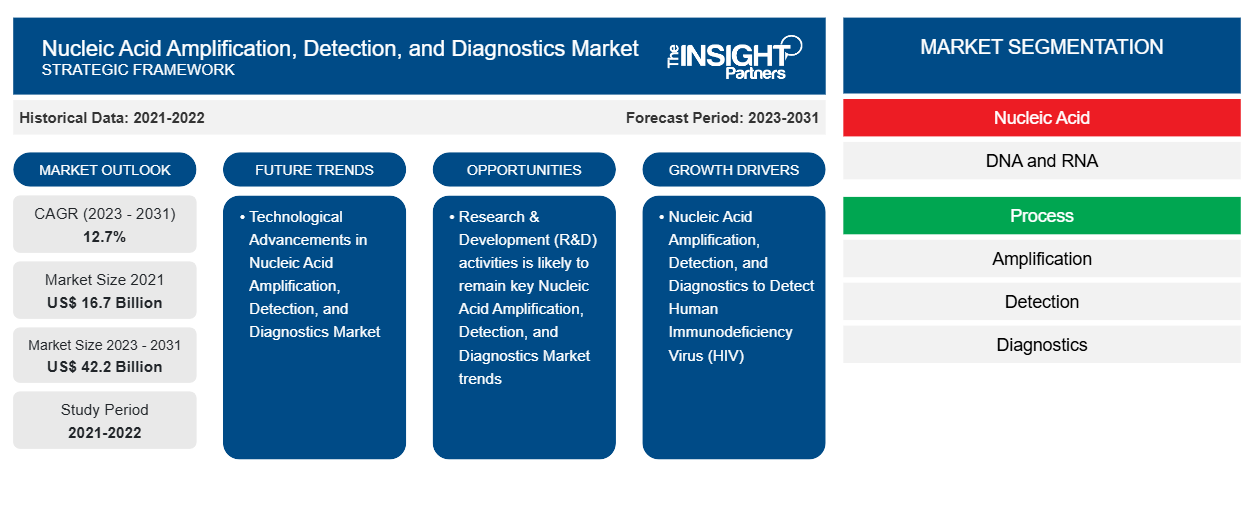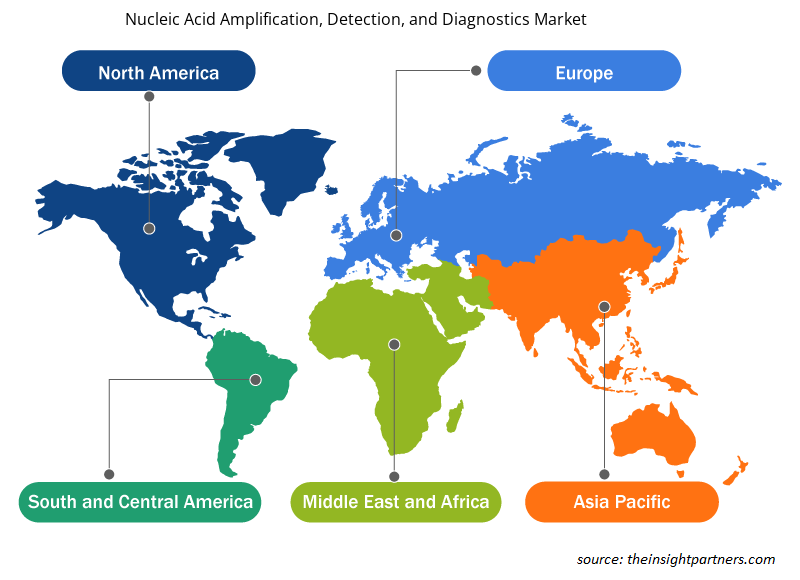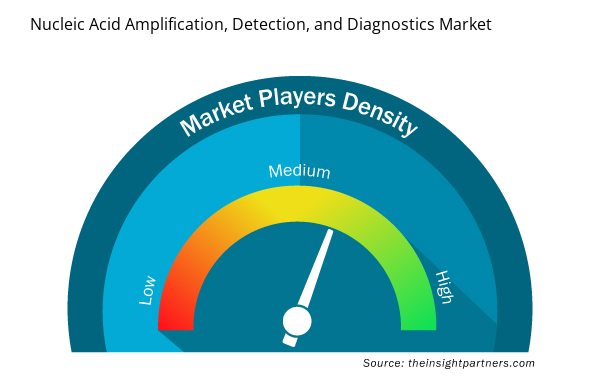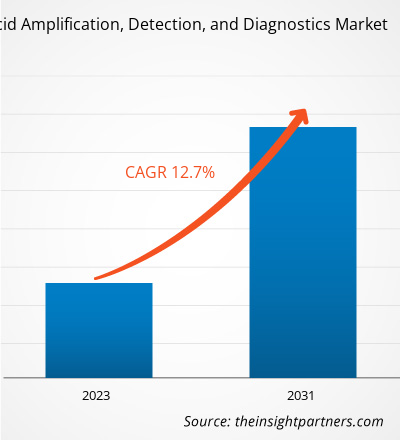The Nucleic Acid Amplification, Detection, and DiagnosticsMarket was valued at US$ 16.7 billion in 2021 and is expected to reach US$ 42.2 billion by 2031. The market is expected to register a CAGR of 12.7% from 2023–2031. Research & Development (R&D) activities is likely to remain key Nucleic Acid Amplification, Detection, and Diagnostics Market trends.
Nucleic Acid Amplification, Detection, and DiagnosticsMarket Analysis
Nucleic Acid Amplification, Detection, and Diagnosticsto Detect Human Immunodeficiency Virus (HIV)
Nucleic acid testing for HIV plays an important role in early diagnosing and monitoring antiretroviral therapy outcomes among HIV patients and HIV-infected infants. For example, isothermal nucleic acid amplification technology overcomes the shortcomings of traditional assays by making it possible to use point-of-care (POC) tests for molecular HIV detection. Additionally, Real-Time Transcription-Mediated Amplification (TMA) is a specific and sensitive type of Nucleic Acid Amplification Test (NAAT) test used to detect and quantify RNA and DNA in a sample. Therefore, the development of nucleic acid amplification, detection, and diagnosticsare the most influential factors responsible for market growth during 2021-2031.
Nucleic Acid Amplification, Detection, and DiagnosticsMarket Overview
Technology, innovation, and smart technological solutions such as continue to influence Nucleic Acid Amplification, Detection, and Diagnostics significantly. Rising nucleic acid amplification, detection, and diagnostics to detect Human Immunodeficiency Virus (HIV) and innovative product launchesare the most influential factors responsible for Nucleic Acid Amplification, Detection, and Diagnostics Market growth. Research & Development (R&D) activities is a key trend for Nucleic Acid Amplification, Detection, and Diagnostics Market growth. Technological advancementswill provide lucrative market opportunities.
Customize This Report To Suit Your Requirement
You will get customization on any report - free of charge - including parts of this report, or country-level analysis, Excel Data pack, as well as avail great offers and discounts for start-ups & universities
Nucleic Acid Amplification, Detection, and Diagnostics Market: Strategic Insights

- Get Top Key Market Trends of this report.This FREE sample will include data analysis, ranging from market trends to estimates and forecasts.
You will get customization on any report - free of charge - including parts of this report, or country-level analysis, Excel Data pack, as well as avail great offers and discounts for start-ups & universities
Nucleic Acid Amplification, Detection, and Diagnostics Market: Strategic Insights

- Get Top Key Market Trends of this report.This FREE sample will include data analysis, ranging from market trends to estimates and forecasts.
Nucleic Acid Amplification, Detection, and DiagnosticsMarket Drivers and Opportunities
Innovative Product Launches in Nucleic Acid Amplification, Detection, and Diagnostics to Favor Market
Manufacturers are designing innovative product launches for NNAT.
- In March 2021, PCR Biosystems, a UK-based DNA and RNA analysis specialist, announced the launching of "IsoFast Bst Polymerase reagents" for rapid, robust, and sensitive DNA and RNA amplification. The new product, "IsoFast Bst reagents from PCR Biosystems," can be used for various techniques such as whole genome amplification, multiple displacement amplification, and isothermal amplification.
- In March 2021, Promega Corporation announced the launching of "XpressAmp Direct Amplification Reagents" that facilitate RNA extraction-free sample preparation. With such an innovative product, laboratories dedicated to testing COVID-19 strains have a new tool that enables them to skip the bottleneck RNA extraction step of the workflow and move directly to PCR amplification. Further, the "XpressAmp Direct Amplification Reagents" are also available as a custom product that can be adjusted in several ways and suits best as per the laboratory's specific needs with options available in bulk purchase, change of dispense sizing, and reformatting & relabelling.
Therefore, innovative product launches will take a considerable market share for nucleic acid amplification, detection, and diagnostics market in the coming years.
Technological Advancements in Nucleic Acid Amplification, Detection, and Diagnostics Market– An Opportunity
Emerging technologies such as isothermal amplification, mass spectroscopy methods, and methylation analysis enable faster and more personalized approaches to patient healthcare. Historically, NAATs have been largely considered highly complex and expensive and, therefore, as a result, have been limited to molecular laboratories staffed with skilled technologists. However, with the emerging COVID-19, molecular diagnostics have undergone many improvements, with the increased need for rapid and precise testing that can be done at the point-of-care (POC). For example, isothermal amplification (IA) techniques amplify nucleic acids at a constant temperature and don't require thermocycling equipment. IA methods, such as loop-mediated isothermal amplification (LAMP) and recombinase polymerase amplification (RPA), depend on enzymatic reactions that amplify target nucleic acid sequences exponentially. The aforementioned techniques are ideal for POC diagnostics as they make kits rapid and easy to use.
Nucleic Acid Amplification, Detection, and Diagnostics
Market Report Segmentation Analysis
Key segments that contributed to the derivation of the Nucleic Acid Amplification, Detection, and Diagnostics Market analysis are candidature and services.
- Based on Nucleic Acid, the Nucleic Acid Amplification, Detection, and Diagnostics Market is bifurcated into DNA and RNA. The DNA may hold a larger market share in 2023.
- Based on Process, the Nucleic Acid Amplification, Detection, and Diagnostics Market is segmented into amplification, detection, and diagnostics. The diagnostics may hold a larger market share in 2023.
- Based on Product Type, the Nucleic Acid Amplification, Detection, and Diagnostics Market is segmented into Assays, Kits & Reagents, and Systems. The Kits & Reagents segment may hold a larger market share in 2023.
- Based on Technology, the Nucleic Acid Amplification, Detection, and Diagnostics Market is segmented into PCR, Isothermal Amplification Technology, Direct Nucleic Acid Detection, NGS, CRISPR-Cas9. The PCR may hold a larger market share in 2023.
- Based on Technology, the Nucleic Acid Amplification, Detection, and Diagnostics Market is segmented into PCR, Isothermal Amplification Technology, Direct Nucleic Acid Detection, NGS, CRISPR-Cas9. The PCR may hold a larger market share in 2023.
Nucleic Acid Amplification, Detection, and Diagnostics Market Share Analysis by Geography
The geographic scope of the Nucleic Acid Amplification, Detection, and DiagnosticsMarket report is mainly divided into five regions: North America, Asia Pacific, Europe, Middle East & Africa, and South America/South & Central America.
North America has dominated the Nucleic Acid Amplification, Detection, and Diagnostics Market. In North America, US accounts considerable share for artificial joints. Presence of top biotechnology manufacturers present in the US and rising R&D activities, and also funded research institutes are the most influential factors responsible for market growth. Asia Pacific is anticipated to grow with the highest CAGR in the coming years.
Nucleic Acid Amplification, Detection, and Diagnostics
Nucleic Acid Amplification, Detection, and Diagnostics Market Regional Insights
The regional trends and factors influencing the Nucleic Acid Amplification, Detection, and Diagnostics Market throughout the forecast period have been thoroughly explained by the analysts at Insight Partners. This section also discusses Nucleic Acid Amplification, Detection, and Diagnostics Market segments and geography across North America, Europe, Asia Pacific, Middle East and Africa, and South and Central America.

- Get the Regional Specific Data for Nucleic Acid Amplification, Detection, and Diagnostics Market
Nucleic Acid Amplification, Detection, and Diagnostics Market Report Scope
| Report Attribute | Details |
|---|---|
| Market size in 2021 | US$ 16.7 Billion |
| Market Size by 2031 | US$ 42.2 Billion |
| Global CAGR (2023 - 2031) | 12.7% |
| Historical Data | 2021-2022 |
| Forecast period | 2023-2031 |
| Segments Covered |
By Nucleic Acid
|
| Regions and Countries Covered | North America
|
| Market leaders and key company profiles |
Nucleic Acid Amplification, Detection, and Diagnostics Market Players Density: Understanding Its Impact on Business Dynamics
The Nucleic Acid Amplification, Detection, and Diagnostics Market is growing rapidly, driven by increasing end-user demand due to factors such as evolving consumer preferences, technological advancements, and greater awareness of the product's benefits. As demand rises, businesses are expanding their offerings, innovating to meet consumer needs, and capitalizing on emerging trends, which further fuels market growth.
Market players density refers to the distribution of firms or companies operating within a particular market or industry. It indicates how many competitors (market players) are present in a given market space relative to its size or total market value.
Major Companies operating in the Nucleic Acid Amplification, Detection, and Diagnostics Market are:
- BD
- bioMeriux SA
- BIO-RAD LABORATORIES, INC.
- Thermo Fisher Scientific, Inc.
- Illumina, Inc.
- Danaher
Disclaimer: The companies listed above are not ranked in any particular order.

- Get the Nucleic Acid Amplification, Detection, and Diagnostics Market top key players overview
Nucleic Acid Amplification, Detection, and DiagnosticsMarket News and Recent Developments
The Nucleic Acid Amplification, Detection, and DiagnosticsMarket is evaluated by gathering qualitative and quantitative data post primary and secondary research, which includes important corporate publications, association data, and databases. The following is a list of developments in them market for Nucleic Acid Amplification, Detection, and Diagnostics:
- In September 2022, Mylab announced the launching of "PathoDetect HPV," a real-time PCR-based screening solution to detect high-risk types of HPV among individuals. Additionally, the company plans to introduce an extension of this kit that can simultaneously detect upto 15 high-risk along with discrimination of HPV 16 & 18, covering more than 95% of cases of cervical cancer.
Nucleic Acid Amplification, Detection, and DiagnosticsMarket Report Coverage and Deliverables
The “Nucleic Acid Amplification, Detection, and DiagnosticsMarket Size and Forecast (2021–2031)” report provides a detailed analysis of the market covering below areas:
- Market size and forecast at global, regional, and country levels for all the key market segments covered under the scope
- Market dynamics such as drivers, restraints, and key opportunities
- Key future trends
- Detailed PEST and SWOT analysis
- Global and regional market analysis covering key market trends, major players, regulations, and recent market developments
- Industry landscape and competition analysis covering market concentration, heat map analysis, prominent players, and recent developments
- Detailed company profiles
- Historical Analysis (2 Years), Base Year, Forecast (7 Years) with CAGR
- PEST and SWOT Analysis
- Market Size Value / Volume - Global, Regional, Country
- Industry and Competitive Landscape
- Excel Dataset



Report Coverage
Revenue forecast, Company Analysis, Industry landscape, Growth factors, and Trends

Segment Covered
Nucleic Acid ; Process ; Product Type ; Technology ; Application ; End User , and Geography

Regional Scope
North America, Europe, Asia Pacific, Middle East & Africa, South & Central America

Country Scope
Argentina, Australia, Brazil, Canada, China, France, Germany, India, Italy, Japan, Mexico, Saudi Arabia, South Africa, South Korea, Spain, United Arab Emirates, United Kingdom, United States

 Get Free Sample For
Get Free Sample For